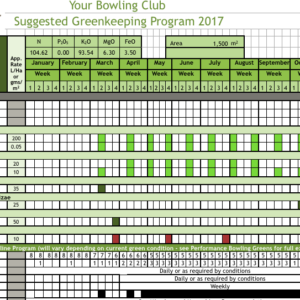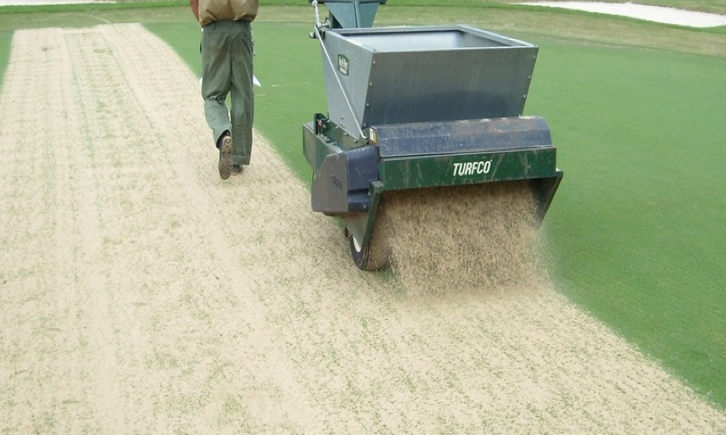It’s that time of the year again when the question arises about the autumn bowling green maintenance program.
Topdressing
Of all the greenkeeping operations we do, top-dressing is certainly the most dramatic as it requires the delivery of bulk supplies of the top dressing medium of choice, usually something very sandy. And due to this relative drama; the big lorry delivering it over the hedge with a crane maybe and science and art of getting it spread evenly on the green by means of special machinery or sheer blood sweat and tears, it seems like it must be doing a lot of good.
It’s also at this time of year I start to get a lot of emails about top-dressing, many of which assume that I am dead set against it and for the most part, I am.
However, there is no one size fits all solution to the questions:
- Should we be top-dressing?
- Is it OK to hollow tine without top dressing afterwards?
- Is it OK to not top-dress a Crown green?
- Should we use 70/30, 60/40 or straight sand?
…and the many other questions that arise at this time.
The autumn renovation program you employ will very much depend on the current condition of your green and there’s no other way to know that other than going and having an educated look.
There’s a pressing need to get to grips with your turf and soil and to develop a deep understanding of your green eco-system that isn’t based on here-say or rumour.
I’ve written a series of articles to help with this assessment process starting here:
Autumn Bowling Green Maintenance Questions Answered
Top-dressing and hollow tining.
Q. If a crown green is hollow tined as part of autumn renovations, I always thought that it needed to be top dressed to refill the holes. Is this correct?
A. There’s no “one size fits all” answer to this and I’m certainly not anti-top-dressing. However, in the vast majority of UK greens there is already too much sand and it contributes to greens becoming inert, lifeless and susceptible to localised dry patch. 70/30 top-dressing is of course 70% sand.
What top-dressing should we buy?
Acid soil?
Q. Following core sampling we have up to two inches of thatch in the wetter area of our green, the thatch is sour smelling and moss is more of a problem there as well. We were told that the soil registered as acidic. We want to help reduce the thatch thickness, correct the acidity and promote healthy grass growth.
Here’s my suggestion (you’ll have to decide if it suits your current conditions):
- Hollow tining (5/8″ tines) at 2″ centres
- Graden (or 600HD Sisis) over the top of the cores
- Clean up debris, brush and clean up cut with mower (>6mm)
- Apply rootzone improvement media such as Humigranule or/and Zeolite, depending on soil textural assessment and organic matter content.
- Autumn fertiliser (Mycogro 5.0.28)
- No top dressing.
- If your green also has Localised Dry Patch, it would be wise to apply suitable treatment.
- Twice monthly deep slit tining (Sisis Autoslit or similar) October to March.
- Twice monthly cut (after slitting and when conditions allow) at 7 or 8mm
Some guidance on assessing the soil and turf conditions here
Questions Please.
If you have questions of your own about autumn maintenance or any other aspect of green maintenance, pease feel free to drop me a line using the contact form.
You can also drop a question in the comments area below.
Done for you, greenkeeping schedules
 There is a growing list of clubs who get in touch with me to see if I can help them to set up a suitable greenkeeping schedule and I can certainly do this given a bit more information. To do this, I will usually ask clubs a few very specific questions about the condition of their green, ask for some photos in some cases, but most importantly, I will review the latest soil analysis for the green in question. Sometimes clubs already have a recent enough soil analysis and I’ll study this and then write a report with a full maintenance schedule aimed at making the improvements the club desires. If they don’t already have this information I can arrange a comprehensive soil analysis and then write my report based on this fresh information.
There is a growing list of clubs who get in touch with me to see if I can help them to set up a suitable greenkeeping schedule and I can certainly do this given a bit more information. To do this, I will usually ask clubs a few very specific questions about the condition of their green, ask for some photos in some cases, but most importantly, I will review the latest soil analysis for the green in question. Sometimes clubs already have a recent enough soil analysis and I’ll study this and then write a report with a full maintenance schedule aimed at making the improvements the club desires. If they don’t already have this information I can arrange a comprehensive soil analysis and then write my report based on this fresh information.



I recently downloaded your ebook Performance Bowling Greens and find it really helpful and informative but one thing I find confusing. At the back you show some maintanence programms and you only show using pencil tines in March. Am I wrong to pencil tine throughout the summer? I thought that the more you spiked the green the better.
Ray Swinnerton (Sandy Town Bowling Club)
Hi Ray
Although more isn’t necessarily better, if your green is thatchy or compacted or affected by dry patch, then more pencil tining will usually be beneficial.
Low disturbance is the eventual aim of the Performance Greens Program, so I recommend sarrell rolling as a means of keeping the surface open during the summer months, but pencil tining more is perfectly OK if it fits with your current conditions.
Thanks
John
Bent Grass
John was very interested in your article concerning round up ready bent grass. We all have thought it was dead for years and years.
A good friend, Pat Christopher from WSU, did his Masters on the problem of its ability to move many miles with wind, birds, ect.
I’d best do some homework today and find some answers. Scary times!
Thank you for your very informative impute, guess we’ve just started scratching the surface
Bob
Thanks for your interest Bob
I’m afraid I don’t know much more than what you’ve read already, but I agree it seems crazy.
If your friend Pat has published anything on this, I’d be interested to read it.
Regards
John